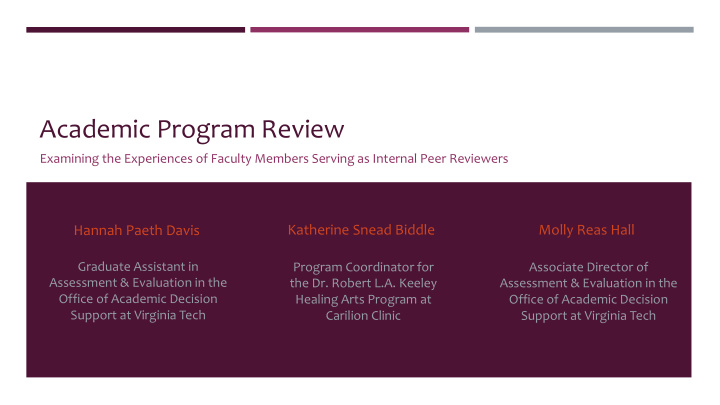



Academic Program Review Examining the Experiences of Faculty Members Serving as Internal Peer Reviewers Katherine Snead Biddle Molly Reas Hall Hannah Paeth Davis Graduate Assistant in Program Coordinator for Associate Director of Assessment & Evaluation in the the Dr. Robert L.A. Keeley Assessment & Evaluation in the Office of Academic Decision Healing Arts Program at Office of Academic Decision Support at Virginia Tech Carilion Clinic Support at Virginia Tech
Faculty Involvement in Assessment Faculty resistance to assessment practices is well-documented (e.g., Rodgers et al., 2013; Shavelson, 2010) Often characterized as burdensome (Wergin & Swingen, 2000) Attitudes and beliefs affect willingness to engage in assessment activities (Emil & Cress, 2014) Faculty commitment promotes a positive culture of assessment (Ndoye & Parker, 2010)
Internal Peer Review Teams in Academic Program Review Cross-evaluation uses constructive communication to promote and encourage learning, as well as to disseminate best practices of assessment (Ketunnen, 2010) Constructive communication between faculty members from different departments promotes innovation and learning from diverse experiences and views (Ketunnen, 2010) Most faculty members do not receive formal training in assessment and are not always aware of resources available to them for assistance (Gentemann, Fletcher, & Potter, 1994)
Virginia Tech’s Academic Program Review Process Utilizing Internal Peer Review Teams
Virginia Tech’s APR Process Relaunched in 2015 Facilitated by the Assessment & Evaluation (A&E) unit Each academic department/program conducts a comprehensive evaluation of its activities every five to six years A member of the A&E unit sits on each peer review team Departments choose either a team of all Internal Peer Reviewers (IPRs) or a mix of internal and external reviewers Departments may nominate reviewers to comprise up to half of the peer review team Peer reviewers are offered a $500 stipend
Methods & Participants Methods Participants 14 full-time faculty members from Virginia Tech Semi-structured interviews 78% response rate Structural coding Wide variety of academic disciplines 8 females and 6 males Focused coding 7 full, 4 associate, and 3 assistant professors Constant comparative method 5 – 40 years higher ed experience; mean = 22 years
Results APR Process “well - executed” and “streamlined” Organized structure “The process isn’t, I don’t want to say intense, but it was thorough” “This felt like the process was genuine in helping this department get better – Improvement focused it was almost like a fresh set of eyes to help them maybe see something differently or suggest some things, which I thought was really really positive” “We had different kinds of questions. Different kinds of perspectives, which I Diverse peer review think was very useful.” teams “The questions we were asked to address were general enough that people from…any discipline would be familiar with what was required to do it”
Results A&E Support “really well versed in how [APR] works and isn’t afraid to do some of the Assessment heavy lifting” professional as point person Freed reviewers up to “be a little more thoughtful or contemplative on a higher level” Resources “prepared pretty well in terms of laying out specific things that they were looking for in terms of the program that we were going Resources to review” A&E staff provided “cues as to how to evaluate success”
Results Learning “came in without very much sense of what it is that we were doing or what we were looking for,” but used the opportunity as a learning experience “which is where I found the value” APR process, purpose, structure “I saw where the weaknesses were, not necessarily just in their program, but in the way they presented their program. And it helped me to think about what it is that program review should be for.”
RESULTS Learning “Being a peer reviewer gave me the opportunity to find out how another department did certain things, like annual reviews, strategic planning, teaching assignments, [and] advising” Other departments “a decent sense of what unique issues other departments are dealing with” and “gives you insight into the bigger picture” of an institution
Results Learning “I think when you do it for other departments, it helps you to think about your own program and your own department” Assessment in Participants mentioned having “a better sense of what to expect,” home developing “sort of a feel from the other side” of the process, and the ability to “contextualize the way my own program looks at itself” departments “walked away from [the APR] wishing that my own department would use [A&E] more effectively…there’s a tremendous value there”
Results Additional Themes and Insights Cross-disciplinary interactions Service to others Participation Recruitment Composition of IPR teams Utilizing junior faculty
Conclusions Our findings suggest that IPRs… Are a viable alternative to external reviewers One strategy for improving faculty perceptions of and participation in assessment activities Contribute to a deeper understanding of the review process Influence changes within reviewers’ home programs Increase the dissemination of best practices for assessment Contribute to building a positive culture of assessment
Discussion
Recommend
More recommend